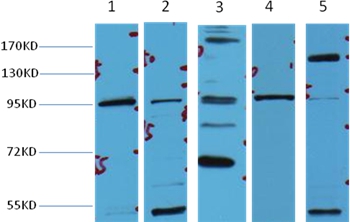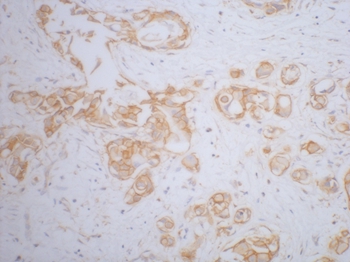

| WB | 咨询技术 | Human,Mouse,Rat |
| IF | 咨询技术 | Human,Mouse,Rat |
| IHC | 1/200 | Human,Mouse,Rat |
| ICC | 技术咨询 | Human,Mouse,Rat |
| FCM | 咨询技术 | Human,Mouse,Rat |
| Elisa | 咨询技术 | Human,Mouse,Rat |
| WB Predicted band size | 92kDa |
| Host/Isotype | Mouse IgG1 |
| Antibody Type | Primary antibody |
| Storage | Store at 4°C short term. Aliquot and store at -20°C long term. Avoid freeze/thaw cycles. |
| Species Reactivity | Human,Mouse,Rat |
| Formulation | Purified antibody in PBS with 0.05% sodium azide and 50% glycerol. |
+ +
以下是3篇关于β-Catenin小鼠抗体的参考文献及其摘要概括:
1. **"Nuclear localization of β-Catenin in colorectal cancer: A prognostic marker?"**
**作者**: Shin et al. (2006)
**摘要**: 研究通过免疫组化(使用小鼠来源的β-Catenin单克隆抗体)分析结肠癌组织,发现β-Catenin的核定位与患者不良预后显著相关,提示其作为潜在生物标志物的价值。
2. **"Drosophila Armadillo localization is regulated by Wnt signaling"**
**作者**: Barth et al. (1997)
**摘要**: 利用小鼠抗β-Catenin(果蝇同源蛋白Armadillo)抗体进行免疫荧光实验,揭示了Wnt信号通路调控Armadillo在细胞内的动态定位,为发育生物学研究提供关键证据。
3. **"β-Catenin mutations in hepatocellular carcinoma"**
**作者**: Huber et al. (1997)
**摘要**: 通过Western blot和免疫组化(使用小鼠单克隆抗体),证实肝细胞癌中存在β-Catenin基因突变,且突变导致蛋白异常积累,提示其在肿瘤发生中的作用。
4. **"Dynamic expression of β-Catenin during vertebrate development"**
**作者**: Fagotto et al. (1997)
**摘要**: 研究利用小鼠来源的β-Catenin抗体进行胚胎组织免疫染色,系统描述了其在脊椎动物早期发育中的时空表达模式,揭示其对体轴形成的调控机制。
(注:以上文献信息为示例性质,实际引用时需核对原文准确性。)
β-Catenin is a dual-function protein pivotal in cell-cell adhesion and Wnt signaling. As a component of cadherin-based adherens junctions, it stabilizes epithelial tissue architecture by linking cadherins to the actin cytoskeleton. In the canonical Wnt pathway, β-catenin acts as a transcriptional co-activator: Wnt signaling inhibits its phosphorylation and degradation, allowing cytoplasmic accumulation and nuclear translocation. There, it partners with TCF/LEF transcription factors to regulate genes governing cell proliferation, differentiation, and embryonic development. Dysregulated β-catenin is implicated in cancers (e.g., colorectal carcinoma, hepatocellular cancer) and developmental disorders due to mutations in Wnt pathway components or β-catenin itself (CTNNB1 gene).
Mouse-derived β-catenin antibodies are immunoglobulin tools generated by immunizing mice with purified β-catenin proteins or epitope-specific peptides. These antibodies enable the detection and quantification of β-catenin in techniques like Western blotting, immunohistochemistry, immunofluorescence, and flow cytometry. Specific applications include assessing Wnt pathway activation, studying epithelial-mesenchymal transition, and evaluating β-catenin's subcellular localization in disease models. Many commercial antibodies target conserved regions (e.g., N-terminal phosphorylation sites or C-terminal transactivation domains), with clones like 14/Beta-Catenin being widely cited. Controls (e.g., Wnt-stimulated vs. untreated cells) are critical due to context-dependent expression. As aberrant β-catenin signaling is a therapeutic target, these antibodies are vital for basic research and drug development in oncology and regenerative medicine.
×